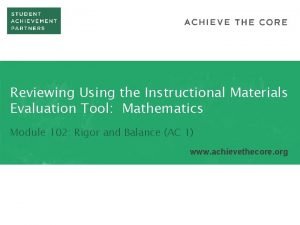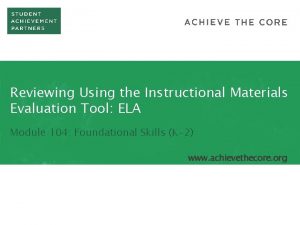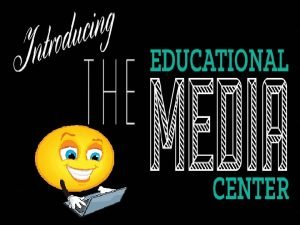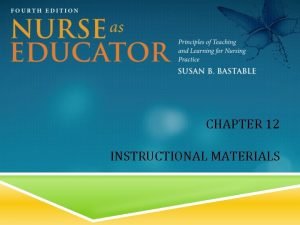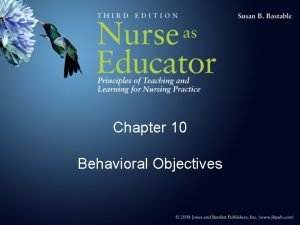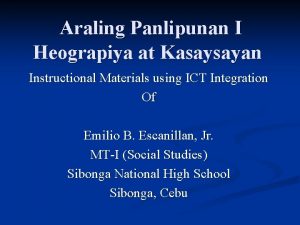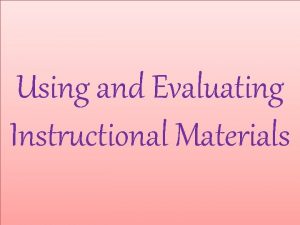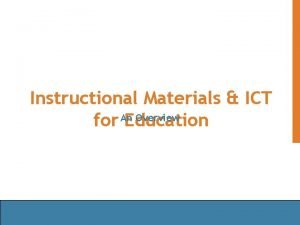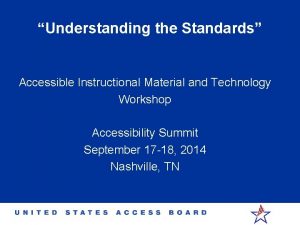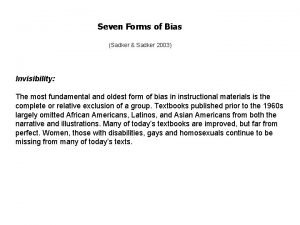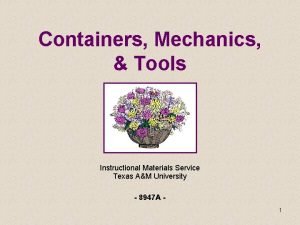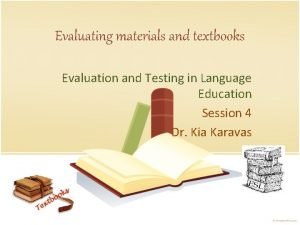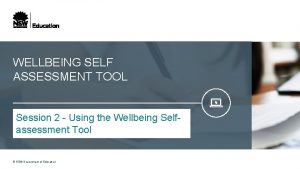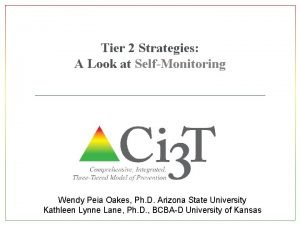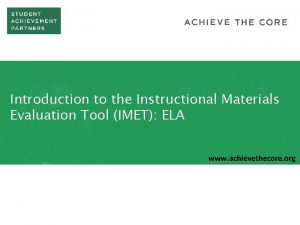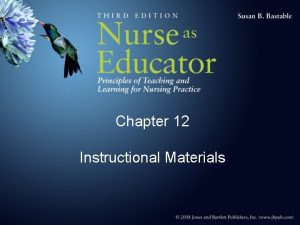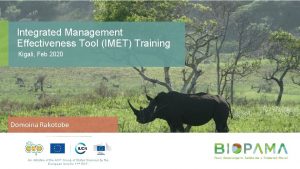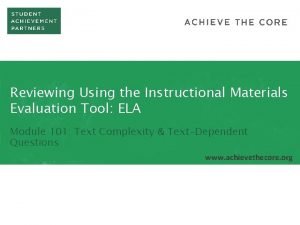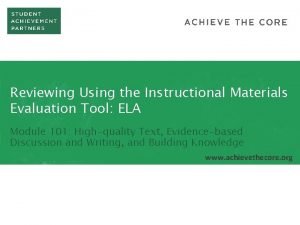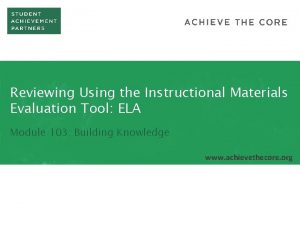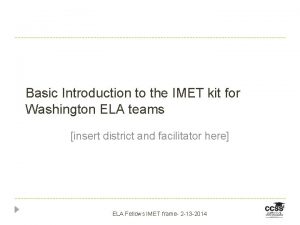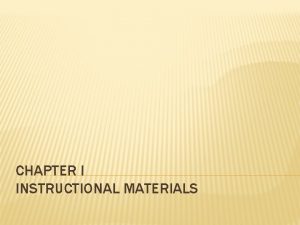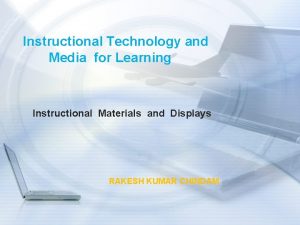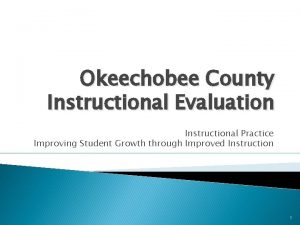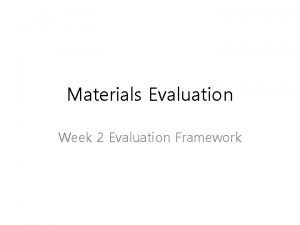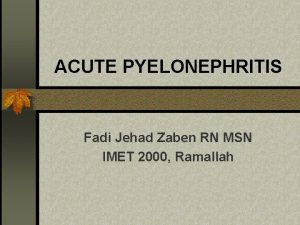Introduction to the Instructional Materials Evaluation Tool IMET















































- Slides: 47

Introduction to the Instructional Materials Evaluation Tool (IMET): Mathematics www. achievethecore. org

“In general, teachers are much more likely to cover topics presented in the materials selected by their school or district than to cover topics not included; they are likely to follow the sequence of topics in the selected materials; and their pedagogical approach is influenced by the instructional design of the materials. The evidence is clear that instructional interactions between students and teachers are framed by the instructional materials that are provided by their schools and districts. ” Chingos & Whitehurst, Choosing Blindly: Instructional Materials, Teacher Effectiveness, and the Common Core PAGE 2

Essential Questions • What is the Instructional Materials Evaluation Tool (IMET)? How is it structured? • How does the IMET enable reviewers to evaluate whether instructional materials are aligned to the major features of the Standards and fulfill the Shifts they require? • How could the IMET be useful in a variety of settings to bring the CCSS and Shifts to life for students? PAGE 3

Goals • Understand that the IMET is a powerful tool that enables reviewers to evaluate whether instructional materials are aligned to the Common Core State Standards • Understand how the structure and levels of alignment within the IMET illuminate the major features of the standards • Consider pertinent uses for the IMET including evaluating new or current curricular materials, developing materials, and professional learning PAGE 4

Agenda • Introduction to the IMET • Find the Shifts • Focus in the IMET • Coherence in the IMET • Rigor in the IMET • Major Features of the Standards in the IMET • Summarizing PAGE 5

What Is the IMET? The IMET is a tool designed to help educators determine whether instructional materials are aligned to the Shifts and major features of the Common Core State Standards. • Designed to be used to evaluate full-year curricula • 2 versions: K-8 and High School • Available at: achievethecore. org/imet PAGE 6

How Do the Publishers’ Criteria Support Use of the IMET? • Developed by the CCSSM writing team, to support faithful implementation by providing criteria for alignment to the Standards • Provide detail and further guidance on criteria and metrics of the IMET PAGE 7

“These standards are not intended to be new names for old ways of doing business. They are a call to take the next step. ” −CCSSM, page 5 PAGE 8

How Is Reviewing Using the IMET Different? Traditionally, judging alignment has been approached as a crosswalking exercise. But crosswalking can result in large percentages of “aligned content” while obscuring the fact that the materials in question align not at all to the letter or the spirit of the standards being implemented. - K-8 Publishers’ Criteria, Spring 2013, p. 1 PAGE 9

What’s in the IMET? • Non-Negotiable Alignment Criteria - Freedom from Obstacles to Focus - Focus and Coherence • Alignment Criteria - Rigor and Balance - Standards for Mathematical Practice - Access for All Students PAGE 10

The CCSS Requires Three Shifts in Mathematics 1. Focus: Focus strongly where the Standards focus. 2. Coherence: Think across grades, and link to major topics within grades. 3. Rigor: In major topics, pursue conceptual understanding, procedural skill and fluency, and application. PAGE 11

Shift 1: Focus ✓Narrow the scope of content ✓Focus deeply on what is emphasized in the Standards Focus strongly where the Standards focus ✓Move away from "mile wide, inch deep" ✓Less topic coverage can be associated with higher scores on those topics covered PAGE 12

Shift 2: Coherence ✓Connect learning within and across grades Think across grades and link to major topics within grades ✓Each standard is not a new event, but an extension of previous learning ✓Mathematics makes sense. PAGE 13

Shift 3: Rigor ✓The CCSSM require a balance of: In major topics, pursue conceptual understanding, procedural skill and fluency, and application -Conceptual understanding -Procedural skill and fluency -Application in problemsolving situations ✓Equal intensity in time, activities, and resources PAGE 14

How Is the IMET Organized? • Review the cards – each represents a metric from the IMET. • As a group, sort the metrics based on which category they fall under: - Freedom from Obstacles to Focus - Focus and Coherence - Rigor and Balance - Standards for Mathematical Practice - Access to Standards for All Students PAGE 15

Activity Discussion Questions • Which metrics are you still not sure about? • Which metrics were hardest to classify? Did any correspond to more than one category? PAGE 16

Focus Non-Negotiable 1: Materials must reflect the content architecture of the Standards by not assessing the specific topics named in Metric 1 A* before the grade level where they first appear in the Standards. IMET p. 4 PAGE 17

Focus Non-Negotiable 2: Materials must focus coherently on the Major Work of the grade in a way that is consistent with the progressions in the Standards. IMET p. 7 PAGE 18

The Shape of Math in A+ Countries Mathematics topics intended at each grade by at least twothirds of 21 U. S. states Mathematics topics intended at each grade by at least twothirds of A+ countries 1 Schmidt, Houang, & Cogan, “A Coherent Curriculum: The Case of Mathematics. ” (2002). PAGE 19

Focus Through Domains PAGE 20

Key Areas of Focus in Mathematics Grade(s) Focus Areas K– 2 Addition and subtraction - concepts, skills, and problem solving and place value 3– 5 Multiplication and division of whole numbers and fractions – concepts, skills, and problem solving 6 Ratios and proportional relationships; early expressions and equations 7 Ratios and proportional relationships; arithmetic of rational numbers 8 Linear algebra and linear functions PAGE 21

Cluster Emphases PAGE 22

Focus Non-Negotiable 1: Materials must reflect the content architecture of the Standards by not assessing the specific topics named in Metric 1 A* before the grade level where they first appear in the Standards. ✓Metric 1 A: Materials reflect the basic architecture of the Standards by not assessing the topics listed below* before the grade level indicated. *No other topics should be added to the list in Metric 1 A. [Note that other topics in the standards are addressed in criterion NN 2. ] PAGE 23

NN Metric 1 A: Topics That Crowd Out Focus in Elementary Grades • Probability, including chance, likely outcomes, probability models (introduced in grade 7) • Statistical distributions, including center, variation, clumping, outliers, mean, median, mode, range, quartiles; and statistical association or trends, including two-way tables, bivariate measurement data, scatter plots, trend line, line of best fit, correlation (introduced in grade 6) • Coordinate transformations or formal definition of congruence or similarity(introduced in grade 8) • Symmetry of shapes, including line/reflection symmetry, rotational symmetry (introduced in grade 4) PAGE 24

Focus Non-Negotiable 2: Materials must focus coherently on the Major Work of the grade in a way that is consistent with the progressions in the Standards. ✓Metric 2 A: Students and teachers using the materials as designed devote the large majority of time to the Major Work of the grade. PAGE 25

Discussion - Focus in Instructional Materials • What does Focus look like in instructional materials? • What are the implications of having materials that are not focused? • How might this information regarding NN 1 and NN 2 A be useful to your current situation? IMET pp. 4, 7 PAGE 26

Coherence Non-Negotiable 2: Materials must focus coherently on the Major Work of the grade in a way that is consistent with the progressions in the Standards. IMET p. 7 PAGE 27

Coherence Non-Negotiable 2: Materials must focus coherently on the Major Work of the grade in a way that is consistent with the progressions in the Standards. ✓Metric 2 B: Supporting Work, where present, enhances focus and coherence simultaneously by also engaging students in the Major Work of the grade. ✓Metric 2 C: Materials follow the grade-by-grade progressions in the Standards. Content from previous or future grades does not unduly interfere with on-grade-level content. ✓Metric 2 D: Lessons that only include mathematics from previous grades are clearly identified as such to the teacher. IMET p. 7 PAGE 28

Coherence: Think Across Grades Example: Fractions “The coherence and sequential nature of mathematics dictate the foundational skills that are necessary for the learning of algebra. The most important foundational skill not presently developed appears to be proficiency with fractions (including decimals, percents, and negative fractions). The teaching of fractions must be acknowledged as critically important and improved before an increase in student achievement in algebra can be expected. ” Final Report of the National Mathematics Advisory Panel (2008, p. 18) PAGE 29

CCSS Grade 4 Grade 5 4. NF. 4. Apply and extend previous understandings of multiplication to multiply a fraction by a whole number. 5. NF. 4. Apply and extend previous understandings of multiplication to multiply a fraction or whole number by a fraction. 5. NF. 7. Apply and extend previous understandings of division to divide unit fractions by whole numbers and whole numbers by unit fractions. 6. NS. Apply and extend previous understandings of multiplication and division to divide fractions by fractions. Grade 6 Informing Grades 1 -6 Mathematics Standards Development : What Can Be Learned from High. Performing Hong Kong, Singapore, and Korea? American Institutes for Research (2009, p. 13) 6. NS. 1. Interpret and compute quotients of fractions, and solve word problems involving division of fractions by fractions, e. g. , by using visual fraction models and equations to represent the problem. PAGE 30

Coherence: Link to Major Topics Within Grades Example: Data Representation 3. MD. B. 3 Draw a scaled picture graph and a scaled bar graph to represent a data set with several categories. Solve one- and two-step “how many more” and “how many less” problems using information presented in scaled bar graphs. For example, draw a bar graph in which each square in the bar graph might represent 5 pets. PAGE 31

Coherence: Link to Major Topics Within Grades Example: Statistics 8. SP. A. 3 Use the equation of a linear model to solve problems in the context of bivariate measurement data, interpreting the slope and intercept. For example, in a linear model for a biology experiment, interpret a slope of 1. 5 cm/hr as meaning that an additional hour of sunlight each day is associated with an additional 1. 5 cm in mature plant height. PAGE 32

Discussion - Coherence in Instructional Materials • What does Coherence look like in instructional materials? • What are the implications of having materials that are not coherent? • How might this information regarding NN 2 be useful to your current situation? IMET pp. 7 -12 PAGE 33

Non Negotiable vs. Alignment Criteria Non- Negotiable Criteria Alignment Criteria Each metric rated Meets/Does Not Meet Each metric rated Meets/Partially Meets/Does Not Meet Every metric must be met to rate the criterion as Meets Must receive 5 out of 6 points to rate the criterion as Meets PAGE 34

Rigor Alignment Criterion 1: Materials must reflect the balances in the Standards and help students meet the Standards’ rigorous expectations. ✓Metric 1 A: The materials support the development of students’ conceptual understanding of key mathematical concepts, especially where called for in specific content Standards or cluster headings. ✓Metric 1 B: The materials are designed so that students attain the fluencies and procedural skills required by the Standards. ✓Metric 1 C: The materials are designed so that teachers and students spend sufficient time working with applications, without losing focus on the Major Work of each grade. IMET p. 13 PAGE 35

What Is Rigor? PAGE 36

The Three-Legged Stool • PAGE 37

Conceptual Understanding 8. EE. C. 8. a Understand that solutions to a system of two linear equations in two variables correspond to points of intersection of their graphs, because points of intersection satisfy both equations simultaneously PAGE 38

Procedural Skill and Fluency 5. NBT. B. 5 Fluently multiply multi-digit whole numbers using the standard algorithm PAGE 39

Application 2. OA. A Represent and solve problems involving addition and subtraction A pencil costs 59 cents, and a sticker costs 20 cents less. How much do a pencil and a sticker cost together? PAGE 40

Discussion - Rigor in Instructional Materials • What does Rigor look like in instructional materials? • What are the implications of having materials that overly focus on one aspect of rigor? • How might this information regarding AC 1 be useful to your current situation? IMET pp. 13 -20 PAGE 41

Standards for Mathematical Practice Alignment Criterion 2: Materials must authentically connect content standards and practice standards. ✓Metric 2 A: Materials address the practice standards in such a way as to enrich the Major Work of the grade; practices strengthen the focus on Major Work instead of detracting from it, in both teacher and student materials. ✓Metric 2 B: Tasks and assessments of student learning are designed to provide evidence of students’ proficiency in the Standards for Mathematical Practice. ✓Metric 2 C: Materials support the Standards’ emphasis on mathematical reasoning. IMET p. 21 PAGE 42

Access for All Students Alignment Criterion 3: Materials must provide supports for English Language Learners and other special populations. ✓ Metric 3 A: Support for English Language Learners and other special populations is thoughtful and helps those students meet the same Standards as all other students. The language in which problems are posed is carefully considered. ✓ Metric 3 B: Materials provide appropriate level and type of scaffolding, differentiation, intervention, and support for a broad range of learners with gradual removal of supports, when needed, to allow students to demonstrate their mathematical understanding independently. ✓ Metric 3 C: Design of lessons attends to the needs of a variety of learners (e. g. , using multiple representations, deconstructing/reconstructing the language of problems, suggestions for addressing common student difficulties). IMET p. 27 PAGE 43

Essential Questions • What is the Instructional Materials Evaluation Tool (IMET)? How is it structured? • How does the IMET enable reviewers to evaluate whether instructional materials are aligned to the major features of the Standards and fulfill the Shifts they require? • How could the IMET be useful in a variety of settings to bring the CCSS and Shifts to life for students? PAGE 44

Use Cases for the IMET • Evaluating current materials • Purchasing decisions • Creation of materials • Professional learning Discussion question: • How will the IMET be useful to you in your context? PAGE 45

Want to Learn More? • Additional Professional Development modules for the IMET are available on achievethecore. org PAGE 46

Thank you!
 Instructional materials evaluation tool
Instructional materials evaluation tool Evaluation tool for instructional materials
Evaluation tool for instructional materials Define educational media
Define educational media Visual instructional materials
Visual instructional materials Still projected display materials
Still projected display materials Disadvantages of behavioral objectives
Disadvantages of behavioral objectives Araling panlipunan instructional materials
Araling panlipunan instructional materials Hayden smith and thomas nagel
Hayden smith and thomas nagel Instructional materials in ict
Instructional materials in ict Instructional materials service
Instructional materials service Examples of accessible instructional materials
Examples of accessible instructional materials Seven forms of bias
Seven forms of bias Parts of flower
Parts of flower Health education plan
Health education plan Instructional materials service
Instructional materials service Checklist for evaluating learning materials
Checklist for evaluating learning materials Cant stop the feeling trolls go noodle
Cant stop the feeling trolls go noodle Materials that can be useful and harmful at the same time
Materials that can be useful and harmful at the same time Man made map
Man made map Adapting and adopting materials
Adapting and adopting materials Direct materials budget with multiple materials
Direct materials budget with multiple materials Wellbeing framework self assessment tool
Wellbeing framework self assessment tool Monitoring and evaluation tool sample deped
Monitoring and evaluation tool sample deped Sip/aip based monitoring and evaluation instrument tool
Sip/aip based monitoring and evaluation instrument tool Classification of cutting tools
Classification of cutting tools Potter's tool is data cleaning tool
Potter's tool is data cleaning tool Hình ảnh bộ gõ cơ thể búng tay
Hình ảnh bộ gõ cơ thể búng tay Lp html
Lp html Bổ thể
Bổ thể Tỉ lệ cơ thể trẻ em
Tỉ lệ cơ thể trẻ em Chó sói
Chó sói Glasgow thang điểm
Glasgow thang điểm Chúa yêu trần thế
Chúa yêu trần thế Các môn thể thao bắt đầu bằng tiếng nhảy
Các môn thể thao bắt đầu bằng tiếng nhảy Thế nào là hệ số cao nhất
Thế nào là hệ số cao nhất Các châu lục và đại dương trên thế giới
Các châu lục và đại dương trên thế giới Công thức tính thế năng
Công thức tính thế năng Trời xanh đây là của chúng ta thể thơ
Trời xanh đây là của chúng ta thể thơ Mật thư anh em như thể tay chân
Mật thư anh em như thể tay chân 101012 bằng
101012 bằng độ dài liên kết
độ dài liên kết Các châu lục và đại dương trên thế giới
Các châu lục và đại dương trên thế giới Thể thơ truyền thống
Thể thơ truyền thống Quá trình desamine hóa có thể tạo ra
Quá trình desamine hóa có thể tạo ra Một số thể thơ truyền thống
Một số thể thơ truyền thống Cái miệng nó xinh thế chỉ nói điều hay thôi
Cái miệng nó xinh thế chỉ nói điều hay thôi Vẽ hình chiếu vuông góc của vật thể sau
Vẽ hình chiếu vuông góc của vật thể sau Nguyên nhân của sự mỏi cơ sinh 8
Nguyên nhân của sự mỏi cơ sinh 8
